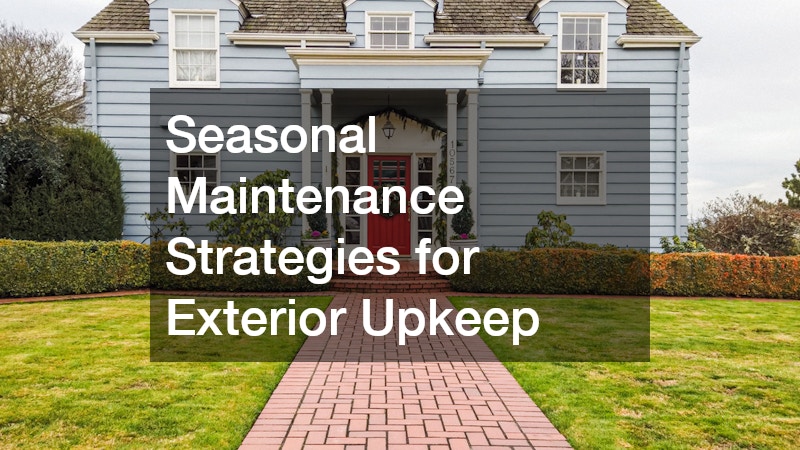Maintaining a home’s exterior requires more than a quick tidy-up; it calls for a proactive, season-specific approach. Seasonal maintenance allows homeowners to address issues before they escalate, helping preserve property value, prevent costly repairs, and create a safer environment. From roof inspections to fence upkeep, each component of your home benefits from targeted care throughout the year.
Ignoring seasonal maintenance can lead to small problems becoming significant headaches. A neglected roof may lead to leaks, while untrimmed trees can damage siding or power lines during storms. Similarly, concrete surfaces can deteriorate without regular care, and fences or gates may warp or rot over time. By integrating strategic inspections, cleaning routines, and preventative measures, homeowners can extend the life of exterior features while maintaining a polished, well-cared-for appearance.
What Are the Best Practices for Seasonal Roof Maintenance?

Inspecting for Damages
Regular roof inspections are crucial for effective seasonal maintenance. Look for missing shingles, cracked tiles, or areas of water pooling, as these issues can escalate quickly. Roofers often recommend checking your roof after heavy storms or during seasonal transitions, when weather fluctuations can expose weaknesses. Minor damages that go unnoticed may lead to leaks, structural issues, or mold growth.
Cleaning Gutters and Downspouts
Gutters and downspouts play a key role in managing rainwater. During seasonal maintenance, clearing debris from gutters prevents water from backing up onto your roof, which can cause leaks and structural damage. Leaves, twigs, and dirt can create blockages that lead to overflow and water penetration.
Ensuring Proper Ventilation
Proper roof ventilation is often overlooked but is vital in seasonal maintenance. Ventilation prevents heat and moisture buildup in your attic, which can damage roofing materials and reduce energy efficiency. Inadequate ventilation can warp shingles, cause mold growth, and shorten the lifespan of the roof.
Inspect vents and attic fans each season to ensure unobstructed airflow. A combination of intake and exhaust vents is ideal for maintaining balanced ventilation. Including roof ventilation in your seasonal maintenance routine improves indoor comfort, reduces energy costs, and extends the life of your roofing system.
How Can I Maintain My Siding Throughout the Seasons?
Inspecting for Cracks and Loose Panels
Seasonal maintenance of siding starts with a thorough inspection for cracks, holes, or loose panels. Damaged siding can allow water and pests to infiltrate the home, leading to more extensive repairs. Local masonry contractors can assist with brick or stone siding, while vinyl siding may require replacement panels for damaged sections.
Cleaning Techniques for Various Materials
Siding materials vary, from vinyl to masonry to wood, and each requires specific cleaning methods. Vinyl siding benefits from a soft scrub with a mild detergent, while masonry may require pressure washing. Wood siding should be cleaned gently to avoid splintering or water absorption.
Seasonal Painting and Sealing
Painting and sealing are essential parts of siding maintenance. Seasonal maintenance ensures that protective coatings are applied during optimal weather conditions, preventing peeling and cracking. Exterior paint shields against moisture, sun damage, and temperature fluctuations, while sealants enhance the durability of wood and masonry surfaces.
What Steps Should I Take for Deck Maintenance Year-Round?
Cleaning and Removing Debris
Decks face constant exposure to the elements, making seasonal maintenance critical. Remove leaves, dirt, and debris to prevent moisture accumulation that can cause mold and wood rot. Concrete cutting may occasionally be necessary for deck bases or stone patios to maintain even surfaces.
Regular cleaning improves safety by reducing slip hazards and preserves the deck’s aesthetic appeal. Seasonal maintenance routines that include thorough cleaning keep the deck functional and visually appealing throughout the year.
Sealing and Staining Recommendations
Sealing and staining protect wood decks from moisture, UV damage, and temperature fluctuations. Seasonal maintenance involves checking the deck’s finish and reapplying sealant or stain as needed. High-quality products enhance longevity and prevent costly repairs.
Local masonry contractors or professional deck specialists can provide guidance on appropriate products and techniques. Incorporating sealant and stain maintenance into a seasonal schedule ensures your deck remains resilient against weathering and continues to complement your home’s exterior.
Checking for Structural Integrity
Beyond aesthetics, decks must be structurally sound. Inspect joists, beams, and railings for cracks, rust, or rot during seasonal maintenance. Loose nails or screws should be tightened, and any compromised components replaced promptly.
Routine checks prevent accidents and protect property value. Seasonal maintenance focused on structural integrity provides peace of mind and ensures your deck remains safe for family gatherings, outdoor meals, and entertainment.
How Do I Care for My Windows and Doors Seasonally?

Inspecting Weather Stripping
Weather stripping plays a key role in energy efficiency and comfort. Seasonal maintenance includes checking for cracks, gaps, or worn areas that could let in drafts, moisture, or pests. Replacing damaged weather stripping helps maintain consistent indoor temperatures and reduces utility costs.
Properly maintained windows and doors also prevent water infiltration that can lead to wood rot or damage to frames. A gate company or local handyman can assist with replacements or adjustments, ensuring that your home stays protected throughout seasonal transitions.
Cleaning Glass and Frames
Regular cleaning of window panes and frames is an important aspect of seasonal maintenance. Removing dirt, dust, and mold not only improves visibility but also prevents long-term damage to frames. Depending on the material, mild detergents, soft cloths, or pressure washing may be appropriate.
Lubricating Hardware Components
Lubricating hinges, locks, and sliding tracks is an often-overlooked step in seasonal maintenance. Proper lubrication prevents rust, stiffness, and wear, making it easier to operate doors and windows.
A routine seasonal maintenance schedule helps identify and address hardware issues before they become inconvenient or costly. Gate companies or local contractors can provide advice on safe, effective lubricants for various materials, ensuring smooth operation and extended hardware life.
What Is the Best Way to Maintain Outdoor Lighting?
Checking Electrical Connections
Outdoor lighting enhances both security and curb appeal. Seasonal maintenance involves inspecting electrical connections for corrosion, loose wires, or exposed cables. Faulty connections can create fire hazards or cause lighting failures.
Hiring a licensed electrician ensures safety when checking and repairing outdoor wiring. Including this step in your seasonal maintenance routine keeps pathways, patios, and entrances illuminated and functional year-round.
Cleaning Light Fixtures
Dirt, insects, and debris can accumulate in outdoor light fixtures. Seasonal maintenance calls for careful cleaning to maintain brightness and prevent damage. Remove bulbs before cleaning to avoid accidents, and use appropriate cleaning solutions for the fixture material.
Upgrading to Energy-Efficient Bulbs
Energy-efficient bulbs reduce electricity consumption while providing reliable lighting. Seasonal maintenance is an ideal time to replace older bulbs with LED or solar-powered options. This not only lowers energy bills but also reduces the frequency of replacements.
Planning upgrades as part of seasonal maintenance ensures consistent lighting performance, enhancing both aesthetics and functionality around your home.
How Can Landscaping Impact Exterior Maintenance?
Choosing Low-Maintenance Plants
Landscaping directly affects the ease of seasonal maintenance. Selecting low-maintenance plants minimizes watering, pruning, and cleanup requirements. Native plants and drought-tolerant species reduce environmental stress and are more resilient to seasonal changes.
Seasonal Pruning and Trimming
Pruning trees and shrubs is essential for safety and aesthetics. Seasonal maintenance ensures branches are trimmed away from roofs, power lines, and fences. Professional tree removal services may be necessary for larger trees or hazardous situations.
Regular trimming prevents storm damage and enhances curb appeal while promoting plant health. Incorporating pruning into your seasonal maintenance routine keeps the landscape safe, attractive, and manageable year-round.
Managing Soil Erosion
Soil erosion can undermine foundations, driveways, and walkways. Seasonal maintenance includes monitoring slopes, planting ground cover, and reinforcing vulnerable areas. Concrete cutting may sometimes be needed to address uneven surfaces caused by erosion.
Proactive soil management protects property investments, prevents water damage, and maintains the integrity of exterior structures. Combining landscaping and structural maintenance strategies ensures your home remains stable and visually appealing.
What Should I Know About Exterior Painting and Staining?

Choosing the Right Season for Painting
Timing is key for exterior paint projects. Seasonal maintenance dictates that painting should occur during mild, dry weather to ensure proper adhesion and curing. Avoid painting during extreme heat, cold, or rainy periods.
Professional painters or local contractors can provide advice on ideal schedules and materials. Correctly timed seasonal maintenance protects surfaces, enhances curb appeal, and maximizes the longevity of exterior paint.
Surface Preparation Techniques
Surface preparation is critical for lasting results. Seasonal maintenance includes cleaning, sanding, scraping, and priming surfaces before painting or staining. Removing old, flaking paint and dirt ensures the new finish adheres properly.
Following these preparation steps during seasonal maintenance preserves wood, masonry, and other materials, preventing premature wear and costly touch-ups.
Maintaining Paint Quality Over Time
Paint and stain degrade over time due to sun, rain, and temperature fluctuations. Seasonal maintenance involves inspecting for peeling, fading, or cracking, and touching up as needed.
Regular upkeep, combined with timely cleaning, protects surfaces and enhances overall property aesthetics. Hiring professional contractors can ensure high-quality, long-lasting results and consistent seasonal maintenance practices.
How Do I Prepare My Home for Winter Weather?
Insulating Pipes and Exposed Areas
Winter preparation is a critical component of seasonal maintenance. Insulating exposed pipes and vulnerable areas prevents freezing, burst pipes, and water damage. Roofers and local contractors can advise on best practices and materials.
Proper insulation during seasonal maintenance also improves energy efficiency and reduces heating costs. Taking these steps proactively ensures your home is protected against harsh winter conditions.
Winterizing Outdoor Furniture
Seasonal maintenance extends to outdoor furniture. Cleaning, covering, or storing furniture prevents damage from moisture, snow, and ice. Durable covers or indoor storage prolongs furniture life and keeps your outdoor spaces looking neat.
By including furniture care in your seasonal maintenance checklist, you safeguard investments while ensuring patios, decks, and porches are ready for use in warmer months.
Checking and Repairing Caulking
Cracked or missing caulking around windows, doors, and exterior joints can lead to drafts, water damage, and mold. Seasonal maintenance involves inspecting and repairing caulking before winter.
What Are the Seasonal Tasks for Maintaining Driveways and Walkways?
Filling Cracks and Holes
Driveways and walkways endure heavy foot and vehicle traffic, making seasonal maintenance essential. Filling cracks and holes prevents water infiltration, which can worsen during freezing and thawing cycles. Concrete cutting may be necessary for more extensive repairs.
Local masonry contractors can assess damage and provide professional solutions. Consistent seasonal maintenance preserves functionality and prevents costly reconstruction.
Cleaning Techniques to Remove Stains
Dirt, oil, and organic matter can stain surfaces over time. Seasonal maintenance involves pressure washing, scrubbing, and applying specialized cleaners to maintain clean, attractive driveways and walkways.
Regular cleaning prevents long-term damage and enhances curb appeal, complementing other exterior maintenance efforts like fencing and landscaping.
Seasonal Sealing Recommendations
Sealing surfaces protects against water damage, cracking, and fading. Seasonal maintenance dictates applying sealants during dry, moderate weather for optimal results. Vinyl fence companies may also recommend protective coatings for gates or fence bases near driveways.
Why Is Seasonal Maintenance Essential for Home Value?

Impact on Curb Appeal
Seasonal maintenance directly influences curb appeal. Well-maintained siding, fences, gates, decks, and landscaping create a polished impression that attracts buyers and enhances neighborhood standing. Exterior paint, roof care, and clean walkways all contribute to a positive first impression.
Regular seasonal maintenance ensures the home looks inviting throughout the year, supporting long-term property value.
Preventing Costly Repairs
Addressing small issues through seasonal maintenance prevents them from developing into major repairs. Neglecting tasks such as roof repair, tree removal, or fence upkeep can lead to significant expenses over time.
Investing in seasonal maintenance is more cost-effective than emergency repairs and protects your home’s structural integrity.
Enhancing Overall Home Safety
Maintaining exterior elements enhances safety for residents and visitors. Seasonal maintenance reduces risks from damaged roofs, unstable decks, falling branches, and uneven walkways. Hiring roofers, fence contractors, or tree removal services ensures professional assessment and safe repairs.
Prioritizing seasonal maintenance creates a secure, functional environment while preserving property value and comfort.
Seasonal maintenance is a vital practice for any homeowner committed to preserving their property’s value, safety, and visual appeal. From routine roof inspections to deck upkeep, siding care, window and door maintenance, and landscaping, every exterior component benefits from targeted seasonal attention. Regular maintenance prevents minor issues from escalating into expensive repairs, protects structural integrity, and enhances energy efficiency.
